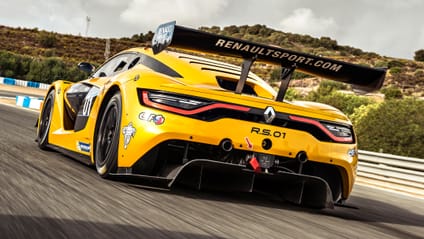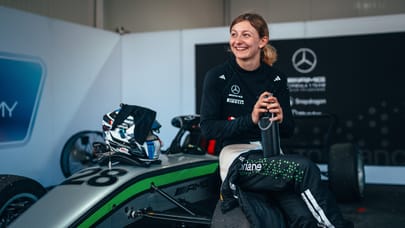
Flat out in Renault's RS 01 racer
Track-only, GT-R-engined 542bhp supercar is on another level. TG straps in tight


God, it’s hot. I’m perspiring like an overweight man in a Chewbacca costume running the New York marathon and strapped in so tightly that it’s becoming unlikely my wife and I will ever have children of our own. I turn my head a few degrees towards a mechanic, before the HANS device halts the rotation, and enquire politely in a higher register than expected exactly why I’ve been left here to boil in my own juices.
“It is raining. We wait for the rain to stop, or we swap the slicks for intermédiaires,” he shouts over the air jacks lifting the car off the pit floor. Secretly I’m hoping we go with the intermediates whatever the meteorological outcome – even on a mildly moist Jerez racetrack, this car is going to be a handful.
Photography: Rowan Horncastle
This feature was originally published in the January 2016 issue of Top Gear magazine.
Advertisement - Page continues below
Why? Because I’m currently a structural part of what is a very serious racecar indeed. Designed to compete in a one-make series – the RenaultSport Trophy – and resembling the offspring of an Audi R8 and a DTM car, the R.S. 01 is roughly a second per kilometre faster than a GT3-spec racer in the right hands. In the wrong hands, it’s a €290,000 rear-wheel-drive projectile.
“The rain has stopped; we stick with the slicks!” No time for arguing now, I’m being lowered onto the concrete and ushered out onto a glistening pit lane. I can hear my heart beating inside my head, my stomach is tied into a perfect sheepshank and, as the world turns slow motion, I cling to a few pacifying thoughts. It’s impossible for me to stall; the bespoke Sadev seven-speed sequential gearbox is without a clutch pedal, so virtually as easy to operate as the Clio RS’s paddle-shift ’box, and fitted with an anti-stall function to avoid embarrassing restarts at crawling speeds.

In front of me is an F1-style wheel strewn with buttons and dials. Literally minutes ago, I was given a full demonstration of its functions, most of which have already escaped my overloaded brain, but the important bits have stuck. I’m hedging my bets: the 11-stage ABS, six-stage traction control and four-stage throttle-sensitivity dials are all twisted to their middle settings, and, given the recent downpour, I reacquaint my left thumb with the orange button marked ‘Wiper’.
Throbbing and shimmying behind me is a dry-sumped version of the Nissan GT-R’s 3.8-litre twin-turbo V6, primed to hammer 542bhp and 465lb ft of torque into the tarmac. The difference here is, unlike the 4WD Nissan, the rear tyres have to cope with the lot. A Dallara-developed carbon monocoque means at 1,120kg it’s 620kg – or an Ariel Atom plus passengers – lighter than the GT-R, too.
Advertisement - Page continues below
Inboard pushrod suspension and adjustable Öhlins dampers, showcased beautifully in the engine bay beneath the rear bodywork, keep those steamroller Michelins in contact with the track, but it’s the aero package that’s the real key to the R.S. 01’s potential. Spoiler, splitters and winglets – so often gratuitous – are deployed to devastating effect. At its top speed, it produces 1.7 tonnes of downforce, several multiples more than a McLaren P1 or LaFerrari at the same speed. The message is clear: this Renault demands commitment to extract its best – big balls, big speeds.

As I peel out of the pit lane and onto the track for the first time, it’s that message that’s ringing in my ears, along with the serrated blare from the straight-through pipes and Colt .45 gunshots on the overrun. Then, at the second corner, still adjusting to the front end’s rabid appetite for turning in, I very nearly overcook it. Too keen on throttle, the back end throws itself wide, smearing rubber the full length of a rumble strip. I catch the slide, just, and refocus on getting some temperature into the tyres and brakes for the rest of the lap.

Lap two, and things are starting to come together. In a straight line, the performance is borderline violent, a ceaseless shove with zero lag, so long as you keep the engine bubbling above 4,000rpm. You stare wide-eyed at the next rapidly approaching bend, wait for the wheel to light up, tug the right paddle, feel the gearbox ram home the next gear and do it all over again. When the time comes to brake, there are mighty stopping forces at your disposal, smothered in an ABS comfort blanket, but to extract them you need thighs like Chris Hoy’s. Stomping on the pedal doesn’t quite cut it, you need to crush it mercilessly with your left boot.

That makes driving it sound physical, a job exclusively for broad chests and trunk-like forearms, of which I have neither. Truth is, it’s a relative pussycat when you crack on. Case in point being the steering: it’s light because it’s power-assisted, but there’s still more feedback than most road cars, barring perhaps a Porsche Cayman GT4. Twitch your wrists, no, think about twitching your wrists, and the front end snaps towards the apex, yet it never feels nervous, just ultra-precise. Get binary with your throttle inputs, and it’ll smoke the rears, as I discovered during my heart-in-gob moment, but it’s not a sudden break away, just a gentle reminderto keep things tidy. In fast corners you can lean on the tyres harder than anything I’ve ever driven.
Advertisement - Page continues below
Lateral grip is out of this world, and thanks to the aggressive aero package only increases as your confidence builds and the speeds spiral upwards. Laurent Hurgon – he who piloted the RenaultSport Megane Trophy-R to a front-wheel-drive Nürburgring lap record – hits the nail on the head: “It’s a tricky car if you want to extract the ultimate lap time, but not if you’re happy to go two seconds slower.” Honestly, I’m several fractions more than two seconds outside the R.S. 01’s ultimate lap time, but I catch his drift.

And then, just as my lap times are beginning to tumble, it starts to rain. Big fat droplets that pummel the bodywork and explode on impact. Within seconds, the track surface is running water, and the brakes and steering have no correlation to the velocity or direction of travel. It’s like riding an elephant on ice skates, and, with the grip stripped away, you’re suddenly aware of the immense forces at work... and the proximity of the barriers. I tiptoe around each corner – my new mission is to deliver the car back to the pits in one piece – and promptly drive straight past the pit entry. One more buttock-clenching lap, and, second time lucky, I bring it home without a scratch on it.
Advertisement - Page continues below
Still drunk on the adrenaline surge and thirsty for more, I corner Jean-Pascal Dauce, director of motorsport, to assess the feasibility of buying one for myself. Long story short: not a chance. Each car (there were 14 entered in the 2015 championship, with 20 expected to be sold by this time next year) costs €290,000 (£208,000) to purchase outright. At this point, owners are welcome to park them up like museum pieces or use them on private track days, but Dauce does everything he can to encourage them to race in the RenaultSport Trophy.

Do so, and running costs are somewhat higher than a Kadjar 1.5dCi. To take part in six race weekends and several test sessions, the entry ticket is €30,000 (£21,000), then you need two drivers, have to pay a team of mechanics, transport the car plus all the equipment and buy official parts, only available from RenaultSport. Per driver, per season, Dauce estimates the damage at around €200,000 (£140,000). By comparison, a season in the Clio Cup is circa €60,000 (£42,000), Formula Renault 3.5 is €850,000 (£600,000) and for F1? Just ask Pastor Maldonado, but something close to the £30m mark should cover it.

Point is, for the performance on offer, the R.S. 01 is a bargain, Dauce will even offer you finance, of a sort. Buy your first car in cash, and the second can be secured with a €30,000 deposit, followed by seven instalments of €10,000 spread across the season. It’s like buying a DFS sofa, just a bit less comfortable.
If the range of handy payment options hasn’t got you reaching for your Amex already, then consider this: there’s a strong chance Renault will complete its Lotus takeover and return to the F1 grid in 2016, at which point the R.S. 01 RenaultSport Trophy series is likely to become a support race, and at Monaco no less, if Dauce gets his way. Just picture it: you, a blur of supercar-shaped yellow blasting around Rascasse, thousands of screaming fans and a quite spectacular racecar beneath you. All for the price of a well-specced Range Rover.
Trending this week
- Car Review
BMW 1 Series
- Top Gear's Top 9
Nine dreadful bits of 'homeware' made by carmakers







